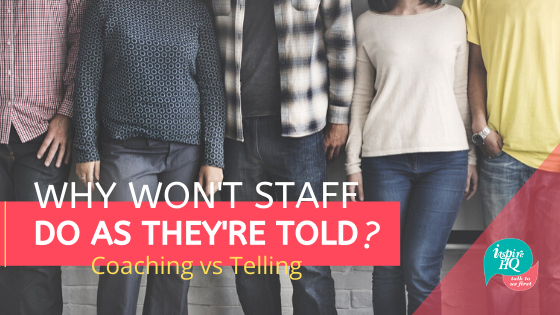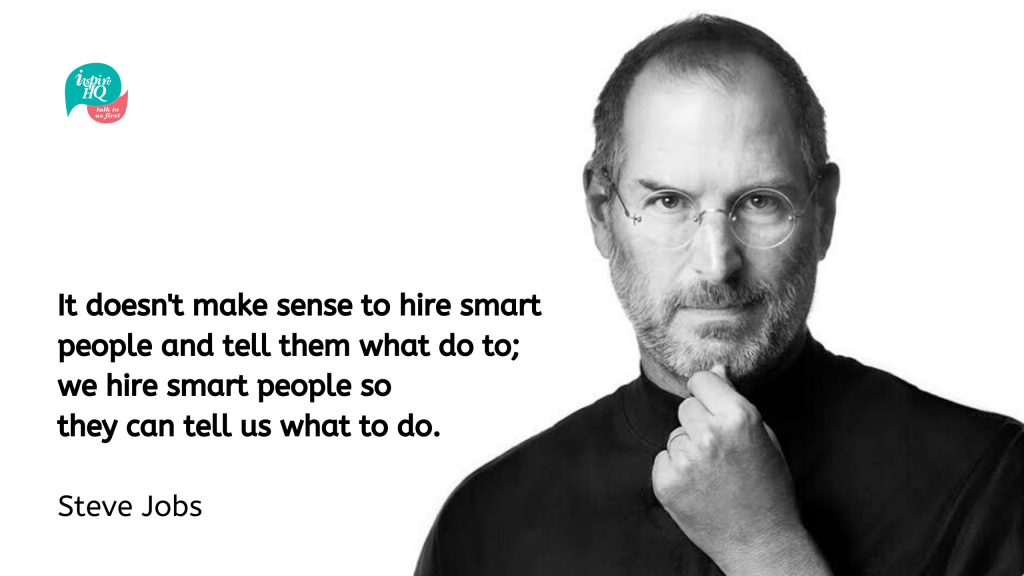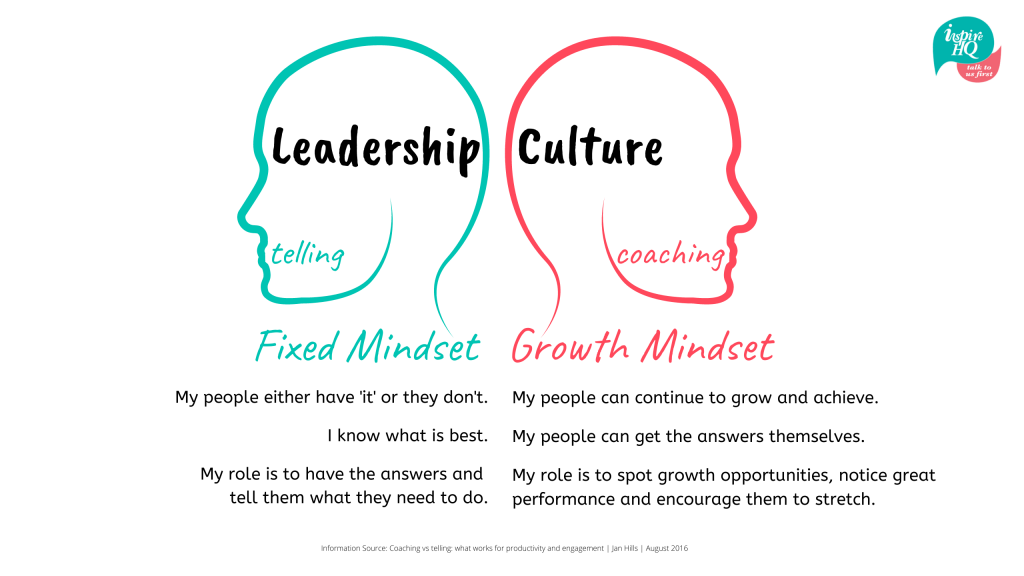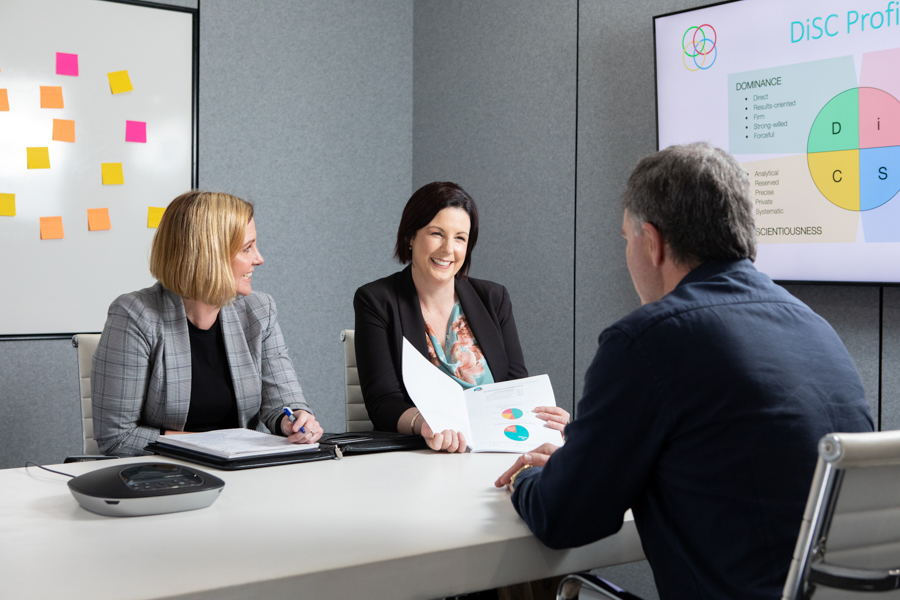Coaching vs Telling
Tell me if this is how you would describe your people: self-sufficient, use their initiative, confident problem solvers, proactively look for better ways of working and have a sense of ownership for their work. Or maybe your day is more like many of the managers I work with, punctuated with statements such as: ‘why can’t they just do what I tell them’, ‘I spend all day answering their questions, I wish they’d just make the call for themselves’, ‘I have spelt out the whole process in detail, why aren’t they following it’, or ‘they just don’t seem to give a $#!t’. There are a range of cultural and structural issues that contribute to how your people work, but the biggest factor is how we lead them. If we want them to change their behaviour, we need to change ours first.
Coaching in the workplace has gone from being a fad to fundamental, but are we actually any good at it? I thought I was. I feel like my days are filled with giving advice, providing feedback and making suggestions. What a shock to find that this isn’t coaching, this is telling! Yes, my approach may have been creating some level of insight, but I was still acting as the problem solver. The person with the ‘knowledge’. Giving advice brings instant gratification, to us, but denies our people the chance to learn, potentially making them reliant on us. We need to resist the temptation to help! Ugh, this could be hard.
If coaching isn’t about feedback and advice, what is it? In its simplest form coaching is about building self-discovery and insight. We want our team to be able to work things out for themselves; they want to have autonomy, control of their choices.
To understand why coaching is so effective, we first need to understand how the brain works. I am no scientist, so forgive my simplistic view of a very complex process. Our brain loves to make connections, it makes over a million of them every second. Our brain also loves order, so in links these new connections (what is occurring now), with what has happened in the past. The science gurus call these ‘mental maps’, but we often call them memories. Without getting to technical, we need our brain to move these connections from the energy-consuming prefrontal cortex to the older, more efficient part of the brain (the basal ganglia), for them to become habits. This can take anywhere from a few minutes to days, depending on how complex the new information is.
Let’s look at what the brain does when we present it with new information. If someone tells us what needs to be done or even gives us advice, our brain is likely to do one of three things: immediately make a mental map, easily linking the new with the past; take time (possibly days) to create the map; or be unable to make the connection and see the information as a threat, something that needs to be avoided or resisted. Our brain is constantly assessing whether it is under threat (he doesn’t trust me, she is telling me to change) or reward (I solved this myself, they ran with my idea). Yikes! This explains why sometimes people resist even the most logical and rational of new ideas.
We want the collective brains of our people to be in reward state as much as possible, and coaching is the answer. To be a successful coach we need two things: 1) we need a growth mindset, we need to believe that our people have the ability to change and grow; and 2) we need to learn to say less and ask more questions that prompt insight.
Let’s look at two well-regarded models that will help us formulate our coaching questions:
The Coaching Habit, Michael Bungay Stanier
What I love about Michael’s work is that he is essentially asking us to be lazier, let the other person do all the work. Below are his 7 essential questions you need to ask. Whilst there is a great flow to these questions, it isn’t necessarily a script and you should feel free to ask any or all of the questions in whatever order feels right:
- The kickstart question: What’s on Your Mind?It’s a good opening question that works.
- AWE question: And, what else? Keeps the advice monster at bay for a bit longer.
- The focus question:What’s the real challenge here for you? The person solving the problem will learn, grow, and take responsibility for the problem.
- The foundation question: What do you want?Ask with a genuine sense of curiosity. It’s a self-management tool too. When you are stressed or wound up, try asking yourself “What do I want?”
- The lazy question: How can I help? Instead of jumping in with advice, it forces the person presenting the problem to make a clearer request. It’s a good question for replying to long emails. “What do you want from me here?”
- The strategic question: If you’re saying yes to this, what are you saying no to? This makes the opportunity cost real. You want to ensure everyone is doing more great work. Great work requires commitment.
- The learning question: What’s been most useful for you?One of your most powerful roles is to be a teacher, and people learn when they reflect.
Source: https://www.thegrowthfaculty.com/blog/GREATIDEASTheCoachingHabitbyMichaelBungayStanier
The GROW Model
Adapted from: https://www.thebalancecareers.com/coaching-questions-for-managers-2275913
The GROW model is a simple method for goal setting and problem solving. The acronym stands for Goal, Current Reality, Options and Will or Way Forward.
Goal
Coaching starts with establishing a goal. It could be a performance goal, a development goal, a problem to solve, or a decision to make.
Suggested Questions:
- What do you want to achieve?
- What would you like to happen with ______?
- What do you want to change?
- Why are you hoping to achieve this goal?
- What would the benefits be if you achieved this goal?
Current Reality
This step helps you both to gain awareness of the current situation – what’s going on, the context and the magnitude of the situation for example. The key is to take it slow and easy with your questions. Let the ‘coachee’ think about the question and reflect on his or her answers.
Suggested Questions:
- What is happening now (what, who, when, and how often)? What is the effect or result of this?
- What is working well right now?
- What do you think is stopping you?
- What did you learn from _____?
- What have you already tried?
- What could you do better this time?
Options
Once you both have a clear understanding of the situation, the coaching conversation turns to what the coachee can do to reach their goal.
Suggested Questions:
- What are your options?
- What could be your first step?
- Who else might be able to help?
- What has worked for you already? How could you do more of that?
- What is the hardest/most challenging part of that for you?
- Which option do you feel ready to act on?
Will or Way Forward
In this last step, you check for commitment and helps the coachee establish a clear action plan for next steps.
Suggested Questions
- How are going to go about it?
- How will you know when you have done it?
- What roadblocks do you expect or require planning?
- What resources can help you?
- Is there anything missing?
- On a scale of one to ten, how committed/motivated are you to doing it?
Of course, it is quicker and easier to just tell someone what to do, until you spend all day giving instructions. This approach is not only a waste of your time and energy, it’s possibly making it harder for your people to accept your new ideas. Coaching is playing the long game. The investment you make in coaching up front, will have a far great return. Your team will be less reliant on you, and be able to make better decisions, solve problems and take more ownership for their work. That’s a win for everyone.
A quote that has stuck with me as I make this transition from ‘advice giver and fixer’ to ‘coach’ is from Michael Bungay Stanier: “Stay curious a little bit longer, rush to action a little bit slower”. Stay curious longer, what a great place to start.
Claire Huntington has over 15 years’ experience in senior and executive level human resource management and strategic leadership positions. Claire learnt HR under the wings of great mentors and through trial and error. She has a very practical hands-on approach to HR and management, and isn’t afraid to look outside the box. Claire is also mum to three school aged firecrackers and is an avid photographer in her spare time.
Disclaimer: The material contained in this publication is of a general nature only. It is not, nor is intended to be, legal advice. If you wish to act based on the content of this publication, we recommend that you seek professional advice.



